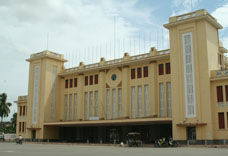
A security guard employed by the TTY Company takes aim at villagers with an assault rifle during a shooting incident in Kratie province last January 2013. Photograph supplied

city.jpg
Phnom Penh's Art Deco railway station was possibly designed by French architect Louis Victor Chaucon, who codesigned Psar Thmey. Construction began in 1928, and the first railway line opened in 1931.
Although Phnom Penh Railway Station is not nearly as avant garde or futuristic as
its spectacular cousin Psar Thmey, this straight-lined "ugly duckling"
of the city's Art Deco treasures is just as worthy of preservation, according to
a range of urban architects.
Due to the decrepit state of Cambodia's two railway lines, the station now maintains
only one passenger train a week: departing for Battambang on Saturday and returning
on Sunday. The journey can take up to 17 hours and is no competition for the country's
steadily improving roads. Only the poorest of travelers opt for the train because
of its low fares, and just one to three freight trains unload at the station each
day.
Inside the station there is a ghostly order: manicured trees, a sparkling soft drink
advertisement, and immaculately painted surfaces. Even the homeless and the panhandlers
seem to keep away. The somnolent scene stands in stark contrast to the dysfunctional
state of Cambodia's railway, which at its peak in the 1960s carried up to two million
people a year.
But if a forlorn atmosphere pervades the once proud structure, its 20-hectare, centrally
located plot has real estate agents excited. One at the Asian Property Company estimated
land prices in the vicinity of the station at around $350 to $600 per square meter.
This would put the total value of the land at about $70 million to $120 million.
"I have been concerned about its fate for some time as unsubstantiated rumors
have been floating around that the land had been sold and the new station would be
on the outskirts of Phnom Penh," Dougald O'Reilly, director of Heritage Watch,
told the Post.
"It is integral to the fabric and character of the capital."
The anonymity of the beige-colored building, may have been enhanced by the absence
of a name on its façade. Darryl Collins, historian at the National Museum
of Cambodia, has never known the building to display a name, and the station's unique
Art Deco modernity ironically makes it look less antique and special than it actually
is.
"Art Deco is a modern style in the way it reflects geometric forms; you'd be
excused for thinking that it looks new," Collins said.
'It's a fine example of 30s architecture. It is worth preserving, without question.
[However] there isn't really legislation to protect anything in Cambodia besides
ancient temples."
Collins believes it should be preserved, even if used for a another purpose.
He said the Art Deco style originated in Paris at the Exhibition Arts Décoratifs
in 1925 and was soon imported into colonial Cambodia.
Architect Geoff Pyle, who said he also heard rumors the station had been sold, said
it was one of the three major concrete buildings of the era in Phnom Penh along with
Psar Thmey and the Roman Catholic Cathedral destroyed by the Khmer Rouge.
"I thinks it's an iconic building for Phnom Penh, a central part of its particular
character," Pyle said.
Nhet Thivuth, project director of Restructuring of the Railways in Cambodia, Ministry
of Public Works and Transport (MPWT), said construction was begun in 1928 and, according
to "an older colleague," was possibly finished in 1929, or in time for
the opening of Cambodia's first railway line, Phnom Penh to Pursat, in 1931.
Architect Helen Grant Ross said it was possibly designed by the famous French architect
Louis Victor Chauchon who co-designed Psar Thmey, completed in 1937. Predating Psar
Thmey by almost a decade, the station is one of Phnom Penh's earliest Art Deco buildings.
Collins confirmed that the detailing and ferro-concrete material used were definitely
similar to Psar Thmey but he had seen no documents mentioning its designer.
Ross fears for the loss of Phnom Penh's older buildings and believes the responsible
officials have no respect for public interest.
"They have absolutely no vision for Phnom Penh," Ross said.
"Phnom Penh is lucky enough to have a railway station [in the city center].
It would be a shame to lose this potential for inner city transport. From the outside
it looks quite boring. It's only when you go inside you notice how beautiful it is.'
The Municipality of Phnom Penh's Master Plan of Phnom Penh by 2020 states that a
new major railway station is proposed for Samraong, near the airport, but that the
central railway station will be preserved. The railway yards to the west of the station
will be transferred to Samraong to make way for the planned development of Boeng
Kak.
When asked by the Post about rumors that the station was to be sold, Thivuth laughed,
and said it was still safely in the hands of the government.
"The central station will be kept as the main passenger terminal, while the
main freight terminal will be in Samraong," Thivuth said.
With the planned repair of Cambodia's dilapidated railway lines in early 2007, aided
by a $42 million loan from the Asian Development Bank, Thivuth said the station would
also be renovated.
"The building will stay the same. But nearby we will build a new building to
meet passenger service requirements," Thivuth said.
Uk Chan, Secretary of State at the MPWT, confirmed that the station would be preserved
in its original state, and that they were now waiting for a feasibility study to
be completed to determine renovation costs.
But the Asian Property Company agent the Post spoke with said he had heard the station
was for sale, and that the main station would be moved to Samraong.
Contact PhnomPenh Post for full article
SR Digital Media'#41, Street 228, Sangkat Boeung Raing, Khan Daun Penh, Phnom Penh, Cambodia
Tel: +855 92 555 741
Email: [email protected]
Copyright © All rights reserved, The Phnom Penh Post





